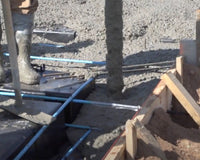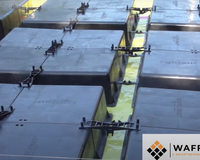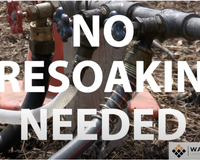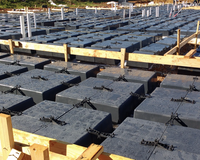When looking to start or expand your business, acquiring the proper building space in which to work is important. One of the most overlooked aspects of construction planning are the types of concrete foundations available for use. The needs for your commercial foundation may be very different from the needs for your house foundations. Being informed on the types of foundations available, and their makeup will help you make the best choice for your light commercial build.
Basic Foundation Types
Some examples of basic foundation design are T - shaped foundations, slab on grade foundations, mat slab foundations and basement foundations. A basement foundation may be your choice foundation for a home, because of the added living space it provides, but could prove costly and inefficient for light commercial needs.
Deep Foundations
You may see very large deep foundations when you see large commercial or high rise buildings being constructed. These deep foundations are for when very large structures with heavy loads are being built. Many of these foundations go deep into the earth and require still piles to be driven into the ground to keep them secure. The Jin Mao tower has piles that go over 250ft below the surface to support it.

Mat Foundations
Mat foundations are made by placing poured concrete on to the ground to form a slab as the foundation of the structure. The thickness of mat foundations vary and go from one foot to as many as 20 feet thick depending on the build. Standard slab thickness for commercial builds is usually 4 to 6 inches.
Footings
Knowing what footings are in construction and how they keep buildings and foundations in place are key to knowing which foundation system works best for your application and soil/climate type. The footing is a part of the foundation that creates the attachment point between the structure and the soil.
Some examples of types of footings are spread footing, stepped footing and trench footing. Footing foundation plans with the correct placement are key, problems may arise if the footing is placed below the water table or span over soft spots. Sometimes footings are misplaced and do not align with foundation walls resulting in costly adjustments.
Geotechnical Aspects
Some foundations are built to use the natural formations of rock and hills and incorporate them into the foundation, these are known as geotechnical foundations. Geotechnical engineers design foundations with the load and size of the structure and the properties of the soil/bedrock in mind. They focus on bearing capacity, or the ability of the soils on site to support the weight of buildings or structures, settlement and ground movement beneath the foundation. Settlement is inevitable in all structures, but it is obviously more of a concern in softer or shifting soil as opposed to bedrock. Geotechnical foundations also account for the contraction and expansion of soil caused by changes in season or climate.
Mat Foundations vs. Slab on Grade
Mat foundations vs slab on grade foundations are able to hold significantly more weight by comparison. They can support heavy loads by spreading the load, with a lower profile into the soil, decreasing the risk for failure in isolated load bearing walls and individual footings.

Slab on grade foundations are designed to be lightly loaded and most times are not reinforced. Mat foundations, sometimes referred to as raft foundations can be used in places where the soil is looser and would normally have less weight bearing capacity because of how they spread the load. Mat floating foundations as they are also called can be used when an existing structure is too close to a property line, and too close to install a footer due to overlapping. Mat foundations are significantly more cost effective to build, needing considerably less concrete, labor and time.
In comparison, for lighter applications, the mat foundation system has proven to be a very cost effective foundation for commercial building. It has also proven to be more environmentally friendly than other commercial building foundation types. Mat foundations can be used in softer soil than foundations requiring deep footers or piles.
Waffle slab foundations such as Wafflemat provide even more flexibility than traditional mat foundations by requiring even less materials while being more resistant to environmental and soil changes. While also being significantly thicker than the industry standard at 8 to 12 inches thick.





